| |
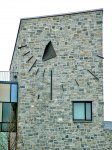 |
Swarthmore |
Pennsylvania |
USA |
Vertical Dial |
Dial 35 |
| Modern design for a vertical dial declining 20.5 deg east on a stone block wall. The gnomon is a right-angled sheet of bronze, casting shadows onto granite hour marks from 6am to 4pm. The dial was designed by Marti Cowan using Waugh's formulae for vertical dials. Frederick Orthlieb, professor and chair of the Dept of Engineering at Swarthmore "had a part in locating the bent-plate gnomon so as to give correct indications on the vertical wall. As installed, the gnomon's indicating edge (which lies on a Polar Axis) casts quite a short shadow in Autumn and Winter and requires some observing skill to make a close estimate of indicated time, but in Spring and Summer the longer shadow moves over the granite hour marks very plainly." A double-line mark at 11am indicates noon during Daylight Saving Time. The second mark is slightly askew if one looks carefully. |
| |
| |
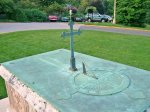 |
Washington |
District of Columbia |
USA |
Horizontal Dial |
Dial 34 |
| A cathedral landmark. 6 foot rectangular crypt with a 2 foot circular horizontal dial in bronze. Adjoining the dial is a cross noon marker that casts its shadow onto the crypt with major Christian holidays marked through the year. Gnomon has a folded shape of 2 cm width but the hour lines form only one dial center although the space at noon gap is 1 cm. |
| |
| |
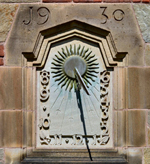 |
New Haven |
Connecticut |
USA |
Vertical Dial |
Dial 30 |
| Vertical dial on Sterling Library. Rectangular stone with hour lines and Arabic numbers. Gnomon is a plain rod emanating from a sunburst. Stonework shows it to be built into the wall of the library. |
| |
| |
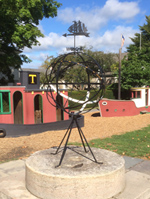 |
Mystic |
Connecticut |
USA |
Armillary Sphere |
Dial 29 |
| This armillary dial with a sailing ship weather vane is on the cover photo of Albert Waugh's book "Sundials - Their Theory and Construction" (paperback edition). The dial sits atop a short stone platform outside of the Treworgy Planetarium, on the grounds of the Mystic Seaport Museum in Mystic, CT. To correct solar time to clock time, the dial has an Equation of Time table at the base. The armillary sphere underwent a restoration in the summer of 2015, removing corrosion, repainting the dial structure and equatorial band, and re-stencilling the longitude degree markings. |
| |
| |
 |
Hartford |
Connecticut |
USA |
Equatorial Dial |
Dial 28 |
| A bronze equatorial dial presented to the college as a gift from the class of 1889. For its age, it is in remarkably good condition. The 3 foot wide by 2 foot tall half cylinder is engraved with both hour and declination lines. At the noon-equinox point of the dial face a perpendicular pole rises to the centerline of the cylinder and supports a N-S gnomon rod. Unfortunately the southern portion of the rod is missing. The base is a square, tapered pillar. |
| |
| |
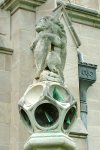 |
Hartford |
Connecticut |
USA |
Polyhedral Dial |
Dial 27 |
| This is an 18th century polyhedral dial (dodecahedron). The dial was originally located at The Abbey, Storrington, Sussex, England. Carved stone with ten dials on a dodecahedral, some sunken, some planar. Pillar is about 12 ft. high. |
| |
| |
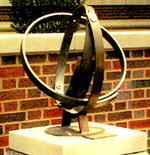 |
Cincinnati |
Ohio |
USA |
Armillary Sphere |
Dial 26 |
| This is an unusual armillary sphere without the standard gnomon rod, allowing the dial to be adjusted easily to tell civil time. As generally expected of an armillary or equatorial sundial, there is an equatorial time ring (16 inches in diameter) with engraved hourly time marks fastened to a meridian ring. But for this dial the equatorial and meridian ring assembly rotates on a polar axis. The dial functions as a Pilkington & Gibbs Heliochronometer: A small hole with lens where the equatorial and meridian rings meet allows a focused spot of sunlight to fall upon the opposite side of the rings where there is a plaque engraved with an analemma and associated monthly and day marks along the curve. This assembly is an analemmic alidade, allowing the user to align the spot of sun to an offset along the analemma curve of date that adjusting the sundial for the equation of time and longitude off time zone meridian. Civil time is read on the equatorial ring from a marker located on a fixed meridian. Knowing the month and approximate day, the dial can be read to the nearest minute. |
| |
| |
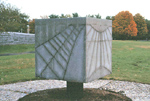 |
Bloomfield |
Connecticut |
USA |
Vertical Dial |
Dial 25 |
| Vertical dial on an eight ton granite cube, 4 foot (1,2m) on a side. Three vertical dials carved into the east, south and west sides. All three gnomons are missing A similar CIGNA cube dial is in Los Angeles, Union Square. Both dials owned by CIGNA Insurance Co. |
| |
| |
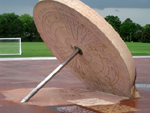 |
Denver |
Colorado |
USA |
Equatorial Dial |
Dial 24 |
| Large Erickson equatorial monument dial. It consists of a disc of pink granite about 6 feet in diameter and 6 inches thick, tilted on edge to align with the earth's equator. The gnomon is a stainless steel rod approximately 3 inches in diameter, piercing the disc at 90 degrees. It supports the disc from below, and protrudes about 2-3 feet above the disc; far enough that it casts a shadow on the face of the disc all summer. Winter shadows fall on the back side of the dial, also engraved with hour lines. |
| |
| |
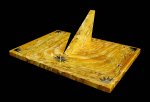 |
Tempe |
Arizona |
USA |
Horizontal Dial |
Dial 23 |
| A horizontal dial from Picture Rock Sandstone with 24k gold-plated inlaid brass fittings, 25 inches wide by 36 inches long, with gnomon 12.5 inches high. Gnomon is 1.5 inches thick. Total sundial weight 110 lbs. |
| |
| |
 |
Arvada |
Colorado |
USA |
Horizontal Dial |
Dial 22 |
| A large horizontal dial of brick and stone with a formed structural steel gnomon in the form of a modern sculpture. Roman numeral hour marks doe DST are on raised brick pillars. |
| |
| |
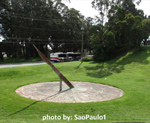 |
Colma |
California |
USA |
Horizontal Dial |
Dial 21 |
| This large ground-level horizontal dial is 40 ft. diameter. Formerly a floral dial with a cypress tree as gnomon and hour lines crafted out of plants such as santilina shrubs. During the 1960's the dial was changed to concrete and aluminum. Now approaching 2020, the concrete dial has a brick surround. Time is marked by large Roman numerals and hour lines in an interior chapter ring. The gnomon is a supported beam with a graceful shaped tip. It may be aluminum, but shows signs of weathering. |
| |
| |
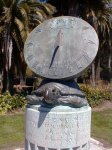 |
San Francisco |
California |
USA |
Vertical Dial |
Dial 20 |
| Known as the "Navigators' Dial", this sundial is dedicated to three early explorers of the California coast. The dial itself is a sliced bronze globe of the earth sitting on the back of a tortoise. Overall, the globe hemisphere is about 2 1/2 feet in diameter, showing the world in relief centered on California. The flat face of the hemisphere is a beautiful vertical reclining dial. The dial sits atop a cylindrical stone column. |
| |
| |
 |
San Diego |
California |
USA |
Vertical Dial |
Dial 19 |
| Above the southwest entrance of the Chemistry-Geology Building is a vertical declining dial built by Richard L. Threet in 1979. The dial uses thin aluminum tubing as a gnomon to cast shadows on a ring of hour and half hour lines approximately 9 feet in diameter. The lines were originally painted black on the white concrete wall with only the 9 am, 12 noon, 3 pm and 6 pm lines boldly numbered. Since then the dial has lost all but the 12. |
| |
| |
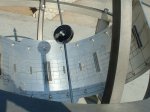 |
Riverside |
California |
USA |
Equatorial Dial |
Dial 18 |
| An equatorial dial 47 inches in diameter made of stainless steel. It sits upon four sleek pillars setting on a concrete rise. The gnomon rod has a round disk with a hole to act as a nodus. The dial equatorial band has solstice and equinox lines, as well as a line showing the declination of the sun marked with by months and zodiac signs. Hour lines are marked by raised stainless steel Roman Numerals. Dial is corrected to Pacific Standard Time. |
| |
| |
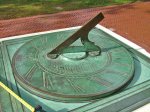 |
Berkeley |
California |
USA |
Horizontal Dial |
Dial 16 |
| A classic horizontal dial 16 inch diameter (41cm) made of bronze. Gnomon is 8 in. (29cm) long, 5 in. (13cm)high. Donated in 1915 by Class of 1877. Nicely engraved Roman hour numerals and delineated every 5 minutes. On the dial face is an Equation of Time table by date. The dial sits atop a marble pedestal, 4 foot (1.2m) high. |
| |
| |
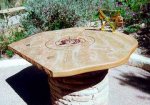 |
Tucson |
Arizona |
USA |
Horizontal Dial |
Dial 14 |
| A 25 inch circular engraved horizontal dial in a large irregular stone. Surrounding the dial on the stone are zodiacal signs and a beautiful engraved drawing of the surrounding mountains. The designer, John Carmichael, calls these dials "horizontal string heliochronometers" since the gnomon is a brass cable held very straight under tension from a heavy counterweight which is suspended from a brass hinged lever. |
| |
| |
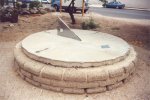 |
Tucson |
Arizona |
USA |
Horizontal Dial |
Dial 12 |
| This concrete and adobe brick horizontal dial is approximately 8 1/2 feet in diameter with a triangular gnomon 25 x 32 inches. This is a large, but very plain sundial except for the shiny chrome plated gnomon. It lacks numerals, but has hour points and shows the cardinal points. The dial is corrected for longitude. The pedestal is missing some bricks and is adorned with graffiti. |
| |
| |
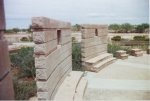 |
Tucson |
Arizona |
USA |
Sun Alignment |
Dial 11 |
| A "Stonehenge" or sun circle dial designed by Chris Tanz, Susan Holman, Paul Edwards and with the help of Will Grundy and sponsored by the Pima County Flood Control and Transportation Dept. The structure uses a broken circle of walls to create designs made of light based on the movement of the sun. The circle, 50 feet in diameter with 8 foot walls is modeled loosely on the Casa Rinconada kiva ruins in Chaco Canyon, N.M. The walls are of integrally colored concrete block, concrete, and flagstone. Lines on a bronze plaque indicate north and south and the direction of sunrise and sunset on the equinoxes and solstices. Holes in the wall do the same. Solar noon is marked when sunlight comes through a slot in the South wall and passes a line on the floor. |
| |
| |
 |
Ottawa |
Ontario |
Canada |
Horizontal Dial |
Dial 10 |
| A bronze 12 inch diameter horizontal dial with hour lines from 4 AM to 8 PM and engraved Roman hour numerals and compass rose. This restoration was donated by Thomas Ritchie who remembered from his youth that the original dial was accidentally destroyed during the construction of the Parliament Library in 1872. The restored dial was unveiled May 19, 1921 by the Governor General, Sir Victor Cavendish, Duke of Devonshire.Dial sits atop light granite pillar approximately 18 inches diameter and 40 inches high. |
| |
| |
 |
Sun City |
Arizona |
USA |
Horizontal Dial |
Dial 8 |
| A monumental horizontal dial in a gravel rock garden. Gnomon is 22 feet high, 40 feet long built from a structural steel "I" beam 64 feet long. Gnomon is supported by three concrete triangular legs and is encased in concrete with four shadow-casting style edges. A circular concrete walkway under the gnomon has painted Roman numeral hour markers. |
| |
| |
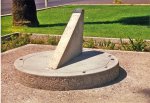 |
Phoenix |
Arizona |
USA |
Horizontal Dial |
Dial 7 |
| This large ground-level horizontal dial designed by Charles Keener. The dial is a circular concrete slab 62 in.(1.6m) in diameter and 8 in.(200cm) thick. The gnomon is 30 in. (762 cm) high, with the shadow casting style 55 in (1.4m) long. The dial has Roman numerals. Unfortunately, the 6AM and 8AM numerals are missing. The dial in a small square plaza surrounded by a row of bushes. |
| |
| |
 |
Westbury |
New York |
USA |
Polyhedral Dial |
Dial 5 |
| An old polyhedral dial set atop a tall stone column on the grounds of Old Westbury Gardens. |
| |
| |
 |
Tucson |
Arizona |
USA |
Equatorial Dial |
Dial 4 |
| A bronze equatorial dial approximately 2 ft. in diameter designed by R. Newton Mayall. Mayall stated, "When I was asked to design the sundial in front of the Museum at Kitt Peak I was more than pleased, for it gave me a chance to work a semblance of astronomy into it. The design reflects the great telescope nearby, with its base and fork type mounting, the dial itself being the "telescope"." |
| |
| |
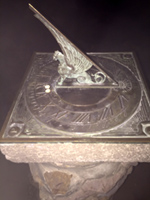 |
Flagstaff |
Arizona |
USA |
Horizontal Dial |
Dial 2 |
| Small bronze horizontal dial with a coarse chapter ring and Roman hour numerals. The gnomon is done as a gryphin. It was a gift from the observatory staff to Dr. Lowell. In a thank you note to his staff, Lowell stated, "Nothing could have pleased me more than that Sundial clothed with its mountain cloak, symbolic of when the sun always shines. It shall be inscribed with all your names and set up on the top of Mars Hill." The original square stone base is replaced by an irregular column of stone and concrete. The square plinth at top still supports the small horizontal dial. |
| |
| |
 |
Carefree |
Arizona |
USA |
Horizontal Dial |
Dial 1 |
| A 90 ft. diameter horizontal dial with a large reflecting pool beneath the gnomon designed by architect Joe Wong and solar engineer John Yellott. The dial is constructed using a steel frame and covered in anodized copper. The hour markers are 4 ft. diameter concrete circles. The dial is designed to show solar time corrected for the time zone offset. Thus the hour markers have been moved ahead of the solar time position. The hour lines are separated by alternating dark and light colored stones. The gnomon itself is 4 ft. wide, 72 ft. long and the tip is 35 ft. high. A pilot dial at a scale of 1/4 in. =1ft. is at the South end of the large dial. It is constructed of gold-anodized aluminum with time lines at 10 minute intervals. An equation of time plaque is nearby. The upper surface of the dial formerly served as a solar water heater to provide hot water to the city's first office building. Numerals face outward, so that they are more easily read by viewers. |
| |